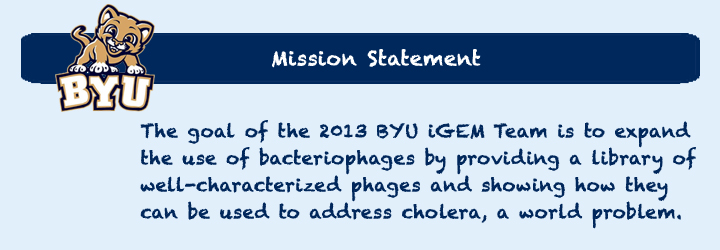Team:BYU Provo/Project
From 2013.igem.org
|
Project Description
 Bacteriophages are the most abundant organism on the planet (estimated at 10 31), yet they are still the most uncharacterized. Historically, bacteriophages have been used to study basic processes of molecular biology. Recent developments have shown that phages are an untapped resource for future technology. For example, phages are used in medicine (drug delivery and phage therapy) and nanoparticle technology (flexible batteries). The goal of the 2013 BYU iGEM Team is to expand the usage of phages by providing a library of well-characterized phage and show how phages can be used to address cholera, a world problem.
Although a natural library of phages already exists, only a few have been approved by the FDA for human use, such as T4 and T7. This approval process costs upwards of $100 million and limits the application of phages. Our goal is to create a library of modified T4 and T7 phages with varying capsid sizes through mutagenesis, purification, and selection. Researchers can choose phages with the appropriate capsid size from this library based on their needs. Such a library expands the useful capacity of these phages, avoiding the full expense of FDA approval for untested phages.
To demonstrate the utility of phage, we built a phage-based enzyme delivery system to address the worldwide problem of cholera. Cholera affects 3-5 million people around the globe each year, is transmitted through contaminated water sources, and is infectious when surrounded by its biofilm. Most prevention methods require a large infrastructure and current treatments target symptoms rather than the cholera itself. Our goal is to transfer quorum sensing genes from cholera into E. coli, allowing it to detect the presence of cholera. When cholera is detected, E. coli will lyse and release Lambda phages that have biofilm-degrading enzymes attached to their tail fibers. This will disrupt cholera biofilms in raw sources of water limiting its ability to cause disease.
|
|
 "
"
